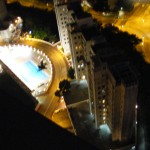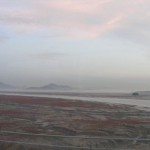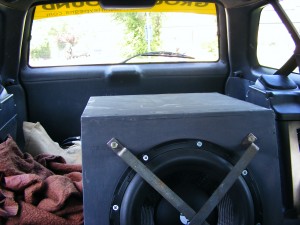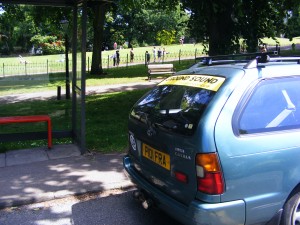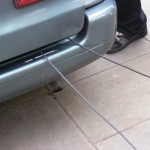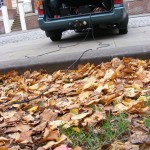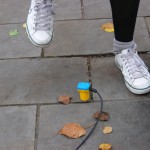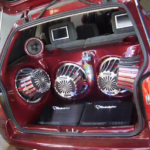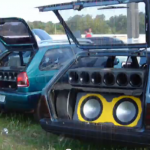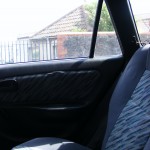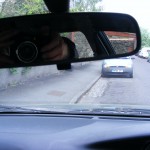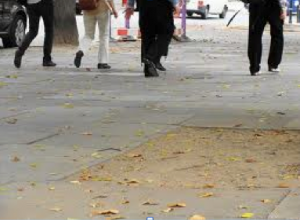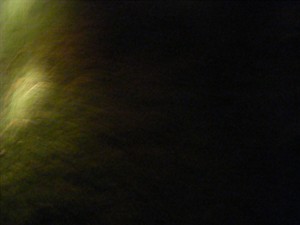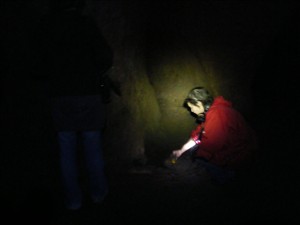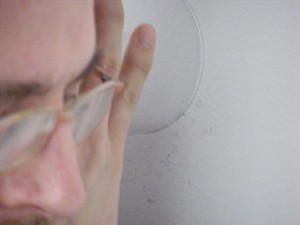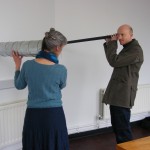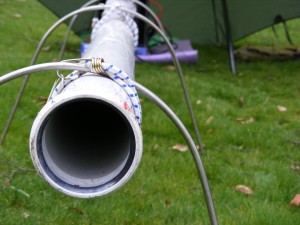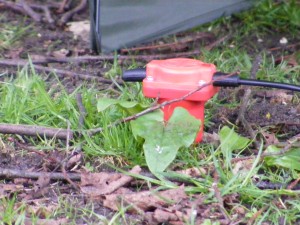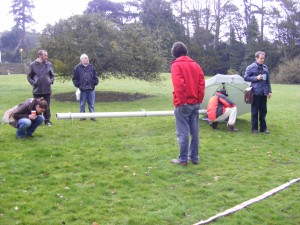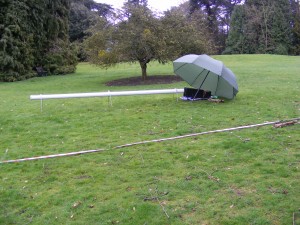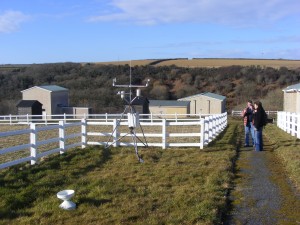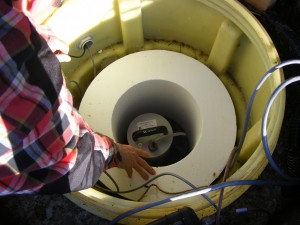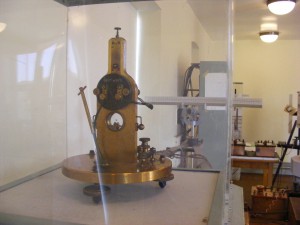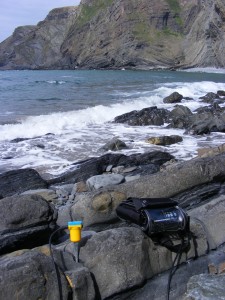Back in the summer I went to visit a friend who kindly said she would come and experience the sound from the ground, from a mic in the ground playing through a sub woofer in my car, and let me write down what she thought about it. Gemma’s experience was going to be different from mine as she is profoundly deaf.

Gemma and Willow
We put a geophone (microphone) 30 meters from the car into the grass in the park and sat in the car and watched the people go by. We felt the vibrations of their feet, and the vibrations of the traffic from the road being picked up by the mic and playing through the subwoofer (speaker).
There was road works about 150m away so after a while we went on to another park away from the main road, and that was quite busy with people walking, children playing, bird song and dogs barking. I attempted to record Gemma’s reactions to the subwoofer’s vibrations, and ask questions that would help me imagine what is was like to experience the world without sound, but visually and through the experience of vibration.

Connecting to the mic in the ground
Shirley. In the ground there is sound \vibration from the city: a low din going on. So even without drills and traffic, there’s quite a lot of noise. What is your reaction to this sound?
Gemma. It’s surprising what noise is there to be amplified – but it’s not obvious here.
S. Have you heard/felt vibrations like these (from the sub) before?
G. Yes.
S. Do you know where the sounds/vibrations are coming from?
G. If I see visually then yes – other wise no.
S. Do you notice, or are you ever aware of vibrations when you don’t know where they are coming from, and is that usual?
G Yes – If I’m around hearing people, I ask what that noise is!! Usually I have to describe what I’m feeling to match what it sounds like.
S. When some one asks me to ‘listen!’ I am aware of lots of sounds I don’t usually tune into. Is this the case with vibration?
G Yes. But only if it’s loud enough for me to feel!!
S. Is there a whole series or gradation of vibration you can identify?
G There are some vibrations I do recognise if I don’t see it – e.g. a ball bouncing on the floor and something being dropped or a glass smashing on the floor.
S. Is it (the vibration from the subwoofer) different if I close the car door?
G. A bit.
S. When the drill isn’t drilling, can you feel the traffic rumble from the road?
G. Yes a bit –
S. How do you feel the vibrations? For example – in your bones or through your skin?
G. In my diaphragm and through my feet.
S. Wow – How did you come to realise this was happening? When you were younger did you remember becoming conscious of it?
G Well, I never really had any hearing after the age of 12, so from the age of 12 I became more conscious of vibrations and since then I’ve made lots of effort to learn and recognise more vibrations.
S. Are you influenced by different vibrations?
G. Irregular vibrations are irritating – man made – gets annoying. Regular rhythms are better nicer.
S. Do you think other deaf and partially hearing people you know feel the some as you?
G Well, I know my family is the same as me, and some deaf people too. I think most deaf people and partially hearing people have some sort of hearing therefore they are more oblivious to vibrations.
S. Do you ever talk about the quality of the ‘vibes’ to other deaf and partially hearing friends?
G Yes – If I’ve seen a band or at a gig that I really enjoyed the vibes from, I try to spread the word!!
S. Do you have a preference to big or small vibrations? Will you get as close as you can to a speaker at a festival – for the excessive experience – or is it uncomfortable – or are you happy to just have a small amount of the vibe?
G Well.. That depends!! Most of the time I do try to be right next to the speaker, but there has been a few places where it’s really overwhelmingly LOUD and it does get too much for me!
S. Do you know musicians or DJs who are deaf?
G Yes! There are a few – Mostly in London.
S. Have you ever come across the percussionist Evelyn Glennie? Yes
As a deaf percussionist, she is very interested in the way we ‘listen’ through our bodies. She became deaf at 8 years old, can hear a bit and lip reads well. http://www.youtube.com/watch?v=YLvkoAZYAkI

http://culture.uoregon.edu/event/1443
She describes hearing as a form of touch. Would you say touch is a form of hearing?
G Yes, Everything speaks volumes through touch and vibrations. E.g. Visually a guitar does not make any sound to me but when I touch it while it’s playing – it’s amazing!! So many vibrations and rhythms etc…
S. Do you go dancing and dance to the vibration of the beat in the music?
G. Yes- like a lot.
S. What are the best beats to dance to?
G. House, reggae, pop – Not complicated Latin rhythms though.
S. Is there anything you can add about the experience of vibration and how it is helpful or pleasurable?
G. Makes me feel heavy. Sometimes I go through a whole host of vibrations every day, and when it gets too much I do want some peace and quiet!! Bit like you having a particularly loud day?? I can feel the bumpy road but the smooth road is quiet.
S. Can you hear or sense that bird? (Black bird singing very loudly close by).
G. No not at all.
S. Do you match up the visuals you are seeing and the vibration you are feeling?
G. Yes it happens all the time. It’s important and alerts me to danger.
S. I wonder how this differs from a hearing person? We all use our hearing to alert us to danger – from crossing the road listening for traffic, to keeping safe from dangerous people like muggers and burglars!! How much do partially and profoundly deaf people depend on vibration for personal safety?
G We don’t – We rely on our eyes for alerts to danger. Vibrations are difficult to judge for danger.
S. Do you feel your own hart beating/vibrating?
G. Yes but I’m used to it. It is alarming when it’s racing and I’m out of breath.
S. What other vibrations alarm you?
G I can’t think of anything – one might be someone running towards me as it gets louder with each step and when I recognise the vibration I do look around to make sure I’m safe.
S. Are there any other internal vibrations from your body that you are aware of? My bones click sometimes. Can you feel that? When you have a thumping head ache, are you sensitive to small vibrations?
Yes! And Yes… I like to stay in bed when I’m hung-over or ill, as I know it’s very very quiet there!!!
S. Can you feel high sounds at all, and if so what are they?
Not really – Maybe a glass smashing as I know that’s high, but not much.
S. There’s a sound artist\musician, Kaffe Mathews, who has made a sound piece that’s bed you lay on that vibrates – sounds saucy! People lie on it and hear the sounds but also become aware of the vibrations. Ooh!! I wanna try that!!
http://www.musicforbodies.net/wiki/SonicBedMarfa

‘Ever felt music through your back? Or slide up and down your legs as it spins round your arms to your fingertips? A Sonic Bed will let you do just that .’ kaffemathews.net
G. I am enjoying thinking where I feel vibration. No one talks about this usually.
S. What else would you like to explore or point out in regard to vibration?
G Personally, there’s so much more music I’ve not listened/felt yet, and it’s limiting when I need a bass box! It’d be amazing if someone invented speaker gloves that I can attach to an I-Pod and listen to music when I’m out and about!!!
I haven’t been dancing for ages. It’s a great freedom.
S. Can you hear of feel your dog Willow?
G. I can’t feel my dog bark, but I can closer up- about a meter away I can. Growling- only if I am touching him can I feel that. I mostly use visual body language to understand my dog – and the others I look after.
G. It would be good if you, and the car subwoofer system, came to the festival with us (deaf group of friends) and we could dance to the bands without having to go up front right next to the speakers – and I could have my dog with me.
S. When we came to the quieter park, I remember you described the small vibration being like the ‘wind’ or the ‘rain’. Inuit have hundreds of words for snow. Have you any other descriptive words for vibrations? Maybe describing strong vibrations…
G. Yes – we describe it easily through sign language and make the vibration visual to help describe it to other deaf and partially hearing people. It’s hard todescribe it in English!!
S. Well thank you- for this fascinating insite into the world of vibration! I am now thinking of more and different questions as I begin to put myself in your place.

G. Thanks to Shirley for an amazing experience of amplified everyday sounds! It helps me to understand more about hearing people and what they listen to and experience the differences in sounds!!

